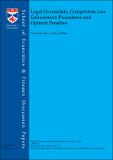Files in this item
Legal uncertainty, competition law enforcement procedures and optimal penalties
Item metadata
| dc.contributor.author | Ulph, David Tregear | |
| dc.contributor.author | Katsoulacos, Yannis | |
| dc.date.accessioned | 2014-10-20T15:01:03Z | |
| dc.date.available | 2014-10-20T15:01:03Z | |
| dc.date.issued | 2014-07-01 | |
| dc.identifier | 155752154 | |
| dc.identifier | 4e55bfcc-9afc-42fc-8b6d-3c7118d3f6b8 | |
| dc.identifier.citation | Ulph , D T & Katsoulacos , Y 2014 ' Legal uncertainty, competition law enforcement procedures and optimal penalties ' School of Economics & Finance Discussion Paper , no. 1410 , University of St Andrews , pp. 1-35 . | en |
| dc.identifier.issn | 0962-4031 | |
| dc.identifier.other | ORCID: /0000-0003-3171-1270/work/59464520 | |
| dc.identifier.uri | https://hdl.handle.net/10023/5564 | |
| dc.description.abstract | In this paper we make three contributions to the literature on optimal Competition Law enforcement procedures. The first (which is of general interest beyond competition policy) is to clarify the concept of “legal uncertainty”, relating it to ideas in the literature on Law and Economics, but formalising the concept through various information structures which specify the probability that each firm attaches – at the time it takes an action – to the possibility of its being deemed anti-competitive were it to be investigated by a Competition Authority. We show that the existence of Type I and Type II decision errors by competition authorities is neither necessary nor sufficient for the existence of legal uncertainty, and that information structures with legal uncertainty can generate higher welfare than information structures with legal certainty – a result echoing a similar finding obtained in a completely different context and under different assumptions in earlier Law and Economics literature (Kaplow and Shavell, 1992). Our second contribution is to revisit and significantly generalise the analysis in our previous paper, Katsoulacos and Ulph (2009), involving a welfare comparison of Per Se and Effects- Based legal standards. In that analysis we considered just a single information structure under an Effects-Based standard and also penalties were exogenously fixed. Here we allow for (a) different information structures under an Effects-Based standard and (b) endogenous penalties. We obtain two main results: (i) considering all information structures a Per Se standard is never better than an Effects-Based standard; (ii) optimal penalties may be higher when there is legal uncertainty than when there is no legal uncertainty. | |
| dc.format.extent | 35 | |
| dc.format.extent | 2549075 | |
| dc.language.iso | eng | |
| dc.publisher | University of St Andrews | |
| dc.relation.ispartof | en | |
| dc.relation.ispartofseries | School of Economics & Finance Discussion Paper | en |
| dc.subject | competition law enforcement | en |
| dc.subject | penalties | en |
| dc.subject | legal uncertainty | en |
| dc.subject | competition policy | en |
| dc.subject | K Law (General) | en |
| dc.subject | HB Economic Theory | en |
| dc.subject.lcc | K1 | en |
| dc.subject.lcc | HB | en |
| dc.title | Legal uncertainty, competition law enforcement procedures and optimal penalties | en |
| dc.type | Working or discussion paper | en |
| dc.contributor.sponsor | Economic & Social Research Council | en |
| dc.contributor.institution | University of St Andrews. School of Economics and Finance | en |
| dc.identifier.grantnumber | RES-062-23-2211 | en |
This item appears in the following Collection(s)
Items in the St Andrews Research Repository are protected by copyright, with all rights reserved, unless otherwise indicated.

